下颌支矢状劈开截骨术共31页
- 格式:ppt
- 大小:3.30 MB
- 文档页数:31


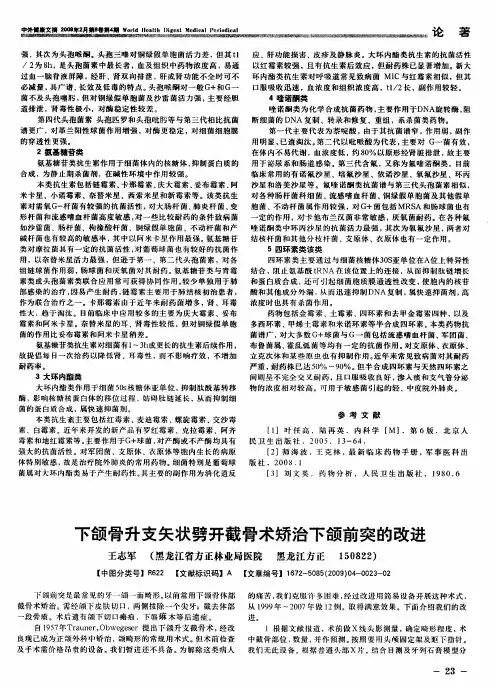
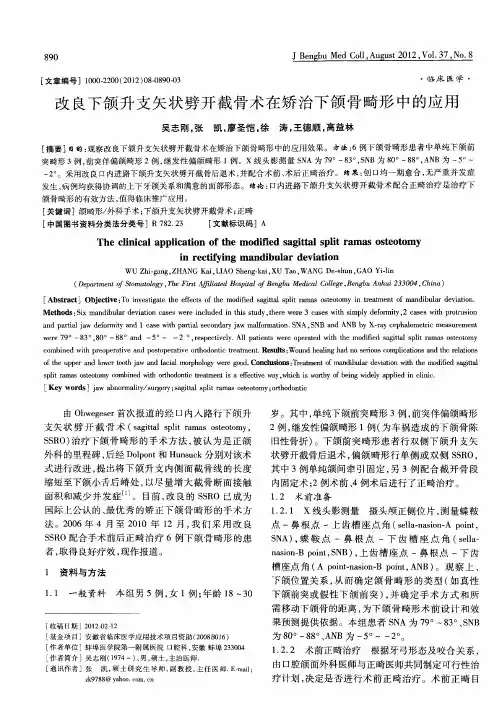

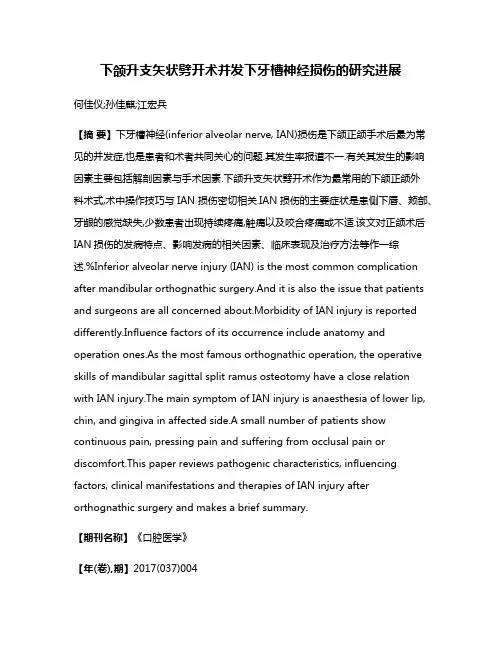
下颌升支矢状劈开术并发下牙槽神经损伤的研究进展何佳仪;孙佳麒;江宏兵【摘要】下牙槽神经(inferior alveolar nerve, IAN)损伤是下颌正颌手术后最为常见的并发症,也是患者和术者共同关心的问题.其发生率报道不一.有关其发生的影响因素主要包括解剖因素与手术因素.下颌升支矢状劈开术作为最常用的下颌正颌外科术式,术中操作技巧与IAN损伤密切相关.IAN损伤的主要症状是患侧下唇、颏部、牙龈的感觉缺失,少数患者出现持续疼痛,触痛以及咬合疼痛或不适.该文对正颌术后IAN损伤的发病特点、影响发病的相关因素、临床表现及治疗方法等作一综述.%Inferior alveolar nerve injury (IAN) is the most common complication after mandibular orthognathic surgery.And it is also the issue that patients and surgeons are all concerned about.Morbidity of IAN injury is reported differently.Influence factors of its occurrence include anatomy and operation ones.As the most famous orthognathic operation, the operative skills of mandibular sagittal split ramus osteotomy have a close relation with IAN injury.The main symptom of IAN injury is anaesthesia of lower lip, chin, and gingiva in affected side.A small number of patients show continuous pain, pressing pain and suffering from occlusal pain or discomfort.This paper reviews pathogenic characteristics, influencing factors, clinical manifestations and therapies of IAN injury after orthognathic surgery and makes a brief summary.【期刊名称】《口腔医学》【年(卷),期】2017(037)004【总页数】5页(P380-384)【关键词】正颌外科;下颌升支矢状劈开术;下牙槽神经;麻木;神经损伤【作者】何佳仪;孙佳麒;江宏兵【作者单位】南京医科大学口腔疾病研究江苏省重点实验室,南京医科大学附属口腔医院口腔颌面外科,江苏南京 210029;南京医科大学口腔疾病研究江苏省重点实验室,南京医科大学附属口腔医院口腔颌面外科,江苏南京 210029;南京医科大学口腔疾病研究江苏省重点实验室,南京医科大学附属口腔医院口腔颌面外科,江苏南京210029【正文语种】中文【中图分类】R782.23经Trauner和Obwegeser改良后的下颌升支矢状劈开术(sagittal split ramus osteotomy, SSRO)在正颌外科领域得到了广泛的应用,现已成为最常用的术式之一[1]。
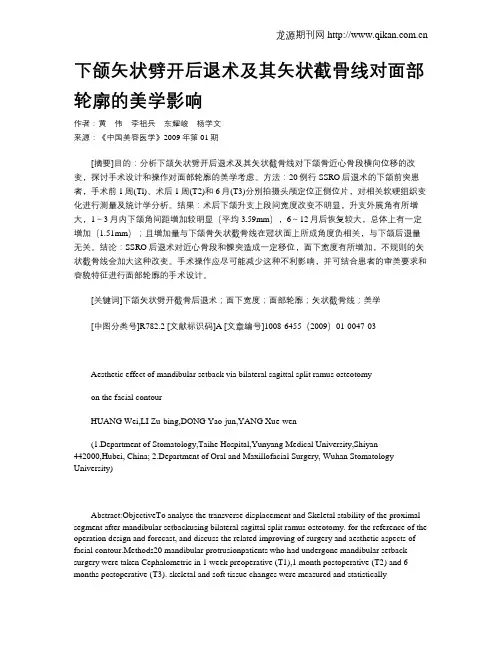
下颌矢状劈开后退术及其矢状截骨线对面部轮廓的美学影响作者:黄伟李祖兵东耀峻杨学文来源:《中国美容医学》2009年第01期[摘要]目的:分析下颌矢状劈开后退术及其矢状截骨线对下颌骨近心骨段横向位移的改变,探讨手术设计和操作对面部轮廓的美学考虑。
方法:20例行SSRO后退术的下颌前突患者,手术前1周(Tl)、术后1周(T2)和6月(T3)分别拍摄头颅定位正侧位片,对相关软硬组织变化进行测量及统计学分析。
结果:术后下颌升支上段间宽度改变不明显,升支外展角有所增大,1~3月内下颌角间距增加较明显(平均3.59mm),6~12月后恢复较大,总体上有一定增加(1.51mm);且增加量与下颌骨矢状截骨线在冠状面上所成角度负相关,与下颌后退量无关。
结论:SSRO后退术对近心骨段和髁突造成一定移位,面下宽度有所增加,不规则的矢状截骨线会加大这种改变。
手术操作应尽可能减少这种不利影响,并可结合患者的审美要求和容貌特征进行面部轮廓的手术设计。
[关键词]下颌矢状劈开截骨后退术;面下宽度;面部轮廓;矢状截骨线;美学[中图分类号]R782.2 [文献标识码]A [文章编号]1008-6455(2009)01-0047-03Aesthetic effect of mandibular setback via bilateral sagittal split ramus osteotomyon the facial contourHUANG Wei,LI Zu-bing,DONG Yao-jun,YANG Xue-wen(1.Department of Stomatology,Taihe Hospital,Yunyang Medical University,Shiyan442000,Hubei, China; 2.Department of Oral and Maxillofacial Surgery, Wuhan Stomatology University)Abstract:ObjectiveTo analyse the transverse displacement and Skeletal stability of the proximal segment after mandibular setbackusing bilateral sagittal split ramus osteotomy. for the reference of the operation design and forecast, and discuss the related improving of surgery and aesthetic aspects of facial contour.Methods20 mandibular protrusionpatients who had undergone mandibular setback surgery were taken Cephalometric in 1 week preoperative (T1),1 month postoperative (T2) and 6 months postoperative (T3). skeletal and soft tissue changes were measured and statistically analyzed.ResultsShort-term changes of the transverse intergonion distance following the surgery weresiginificant,It showed an increased mean amount by 3.59 mm and a lot relapse 6~12 months postoperative, the total increase is1.51 mm. Statistical analysis showed No correlation between mandibular satback and transverse displacement of the proximal segment. significant negative correlation was found between the increase of the intergonion distance and the angle formed by thesaggital osteotomyline.ConclusionThere were some displacement of the proximal segment and ramus after mandibular setbackusing bilateral sagittal split ramus osteotomy.,including an increase of the transverse intergonion distance . those changes can be aggravated by the irregular sagittal osteotomy line .as a result, surgical operation should be improved to minimize such adverse effects,and the the patient`s aesthetic preference and facial contour should be taken into account to make a better operationdesign Key words: SSRO(sagittal split ramus osteotomy);transverse intergonion distance;facial contour;sagittal soteotomy line;aesthetics正颌外科手术设计主要以头颅侧位片和正常牙合人群为参照,头颅正位片所反映的面部轮廓以及美貌人群所代表的符合审美要求的面型关系,因手术中涉及较少而易被忽视。
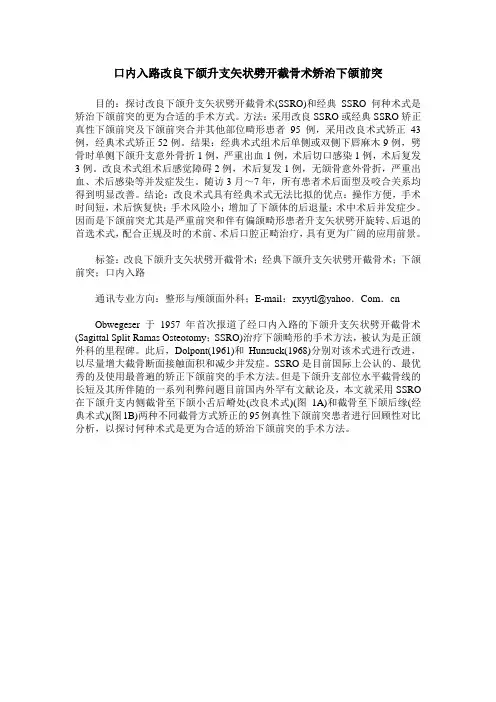
口内入路改良下颌升支矢状劈开截骨术矫治下颌前突目的:探讨改良下颌升支矢状劈开截骨术(SSRO)和经典SSRO何种术式是矫治下颌前突的更为合适的手术方式。
方法:采用改良SSRO或经典SSRO矫正真性下颌前突及下颌前突合并其他部位畸形患者95例,采用改良术式矫正43例,经典术式矫正52例。
结果:经典术式组术后单侧或双侧下唇麻木9例,劈骨时单侧下颌升支意外骨折1例,严重出血1例,术后切口感染1例,术后复发3例。
改良术式组术后感觉障碍2例,术后复发1例,无颌骨意外骨折,严重出血、术后感染等并发症发生。
随访3月~7年,所有患者术后面型及咬合关系均得到明显改善。
结论:改良术式具有经典术式无法比拟的优点:操作方便,手术时间短,术后恢复快;手术风险小;增加了下颌体的后退量;术中术后并发症少。
因而是下颌前突尤其是严重前突和伴有偏颌畸形患者升支矢状劈开旋转、后退的首选术式,配合正规及时的术前、术后口腔正畸治疗,具有更为广阔的应用前景。
标签:改良下颌升支矢状劈开截骨术;经典下颌升支矢状劈开截骨术;下颌前突;口内入路通讯专业方向:整形与颅颌面外科;E-mail:zxyytl@yahoo.Com.cnObwegeser于1957年首次报道了经口内入路的下颌升支矢状劈开截骨术(Sagittal Split Ramas Osteotomy;SSRO)治疗下颌畸形的手术方法,被认为是正颌外科的里程碑。
此后,Dolpont(1961)和Hunsuck(1968)分别对该术式进行改进,以尽量增大截骨断面接触面积和减少并发症。
SSRO是目前国际上公认的、最优秀的及使用最普遍的矫正下颌前突的手术方法。
但是下颌升支部位水平截骨线的长短及其所伴随的一系列利弊问题目前国内外罕有文献论及,本文就采用SSRO 在下颌升支内侧截骨至下颌小舌后嵴处(改良术式)(图1A)和截骨至下颌后缘(经典术式)(图1B)两种不同截骨方式矫正的95例真性下颌前突患者进行回顾性对比分析,以探讨何种术式是更为合适的矫治下颌前突的手术方法。
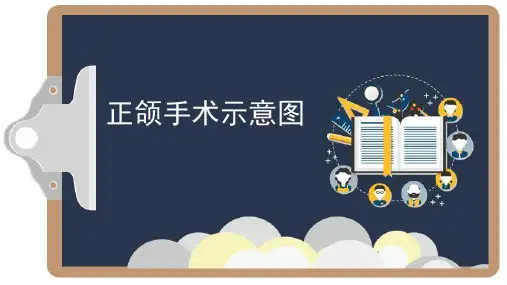
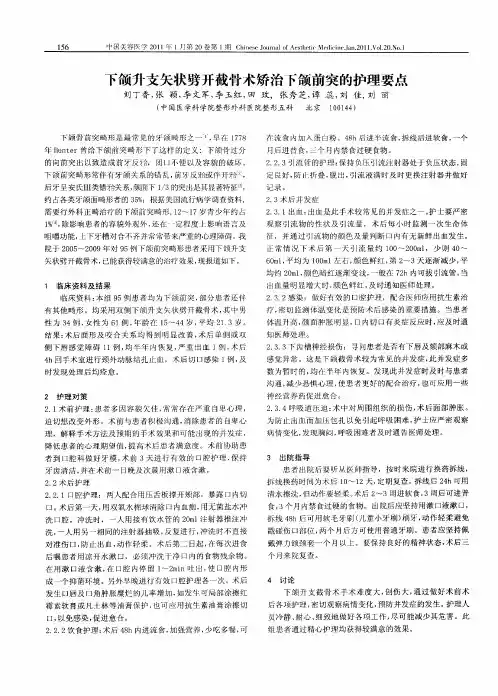

医院口腔外科下颌支矢状骨劈开术操作规范【适应证】1.用于前伸下颌,矫治下颌发育不足后缩畸形。
2.亦可用于后退下颌,矫治下颌发育过度前突畸形。
3.与其他手术配合,矫治伴有骨性下颌后缩或骨性下颌前突的双颌畸形等复杂病例。
【禁忌证】同下颌支斜行(垂直)骨切开术。
【操作程序及方法】1.本手术均经口内路径施行。
口内黏膜切口基本同下颌支斜行骨切开术。
2.剥离与显露。
用升支剥离器紧贴下颌支前缘骨面由下而上剥离颏肌附着直达喙突。
于下颌支内侧,在下颌孔平面以上紧贴骨面,分离软组织至显露进入下颌孔的下牙槽神经血管束。
继于下颌支与下颌体相交部的颊侧,分离软组织,至下颌第二磨牙颊侧达下颌下缘。
3.在下牙槽神经血管束进入下颌孔的上方,用裂钻水平向切开下颌支内侧骨板,其后界止于下颌孔后缘0- 5cm处。
4.由内侧水平骨切开线前端向下,经下颌支前缘,过外斜线,在下颌第二磨牙颊侧相应处转而垂直向下,呈矢状及垂直向切开颊侧骨外板直达下颌下缘内侧。
如用于后退下颌,则按设计后退量,在垂直骨切开线后方,切除相应的颊侧骨板。
5.用双面薄刃骨凿,分别经下颌支与下颌支体交界部的骨沟进入,在外侧骨板与松质骨之间逐步完成骨劈开术。
并用骨凿插入劈开骨间隙,做缓慢旋转性撬动,分离已劈开的近心骨段,至远心骨段能无明显阻力的前后移动。
用同法在对侧施术。
6.将导板戴至上颌。
牵引远心骨段至理想位置,并使其上、下牙列与导板吻合。
用橡皮圈做颌间弹性固定。
7.确认双侧髁突、咬合关系居正常位后,在近远心骨段重叠部用小型钛板或钛镙钉固定。
8.冲洗创腔,分层缝合创口。
【注意事项】1.术后观察同下颌支斜行骨切开术。
2.用钢丝骨内栓结固定者,术后颌间弹力牵引固位至少保持6周。
3.本手术最常见的并发症是下牙槽神经、血管损伤引起的术中大出血及术后下牙槽神经分布区出现的感觉障碍,以及骨段移位引起的开与颞下颌关节症状等。
故术中应注意相应操作牢靠的固定,术后及时处理出现的问题。
心理干预在下颌升支矢状劈开截骨术后肌功能康复训练中的作用邹虹;张华;李雪美;彭郁林;李丽;吴迪宾【期刊名称】《口腔医学研究》【年(卷),期】2012(28)6【摘要】目的:探讨心理干预在下颌升支矢状劈开截骨术(sagittal split ramus osteotomy,SSRO)矫治下颌前突畸形术后肌功能康复训练中的作用。
方法:60例接受下颌升支矢状劈开术的患者随机分为实验组和对照组,2组均接受系统治疗和肌功能康复训练,实验组在此基础上增加心理干预,测量术前、术后2、4周的张口度;术前、术后4、8周的焦虑自评评分和力。
结果:实验组术后4周时张口度已接近术前水平,术后8周时力接近术前水平,焦虑情绪改善,实验组各方面参数相比对照组都有明显提高。
结论:系统地心理干预能有效地提高患者健康知识水平,改善认知态度,使焦虑情绪得以改善,医患配合度提高,从而提高治疗有效率。
【总页数】3页(P583-585)【关键词】心理干预;肌功能康复训练;下颌升支矢状截骨术;张口度;力力;焦虑【作者】邹虹;张华;李雪美;彭郁林;李丽;吴迪宾【作者单位】北京大学深圳医院五官科【正文语种】中文【中图分类】R782.2【相关文献】1.下颌升支矢状劈开截骨术对下牙槽神经功能的影响 [J], 程波;东耀峻2.下颌升支矢状劈开截骨术后颞下颌关节形态和功能变化 [J], 华泽权;刘妍琼;宋九余;陈志洪3.下颌升支矢状劈开截骨术后退和前徙下颌骨对下颌运动范围的影响 [J], 杨学文;东耀峻;张国志4.下颌升支矢状截骨术后肌功能康复训练的临床探讨 [J], 杨学文;龙星;东耀峻;陈红生;孙绍山5.改良下颌升支矢状劈开截骨术在矫治下颌骨畸形中的应用 [J], 吴志刚;张凯;廖圣恺;徐涛;王德顺;高益林因版权原因,仅展示原文概要,查看原文内容请购买。